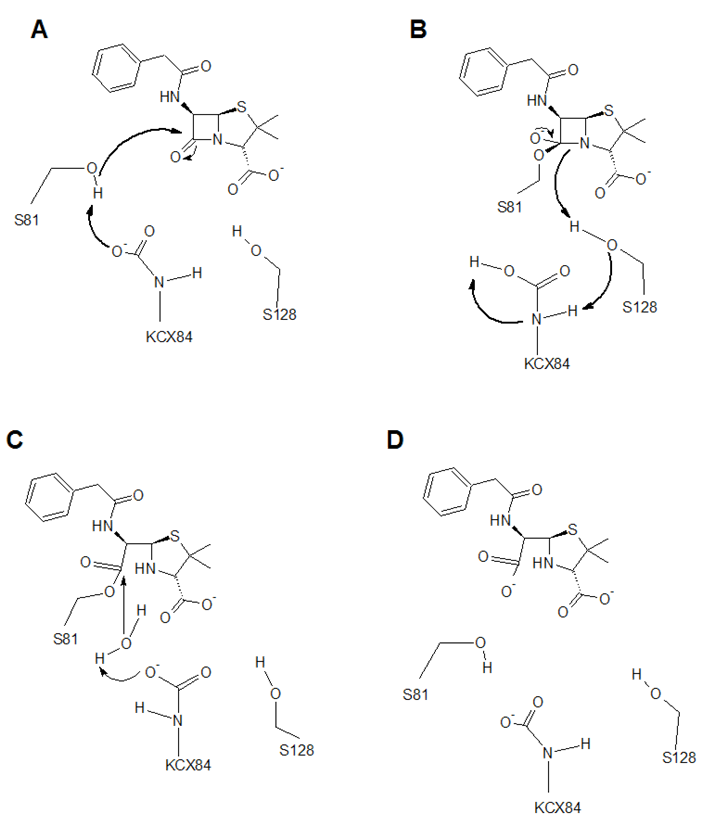This is a default text for your page '. Click above on edit this page' to modify. Be careful with the < and > signs.
You may include any references to papers as in: the use of JSmol in Proteopedia [1] or to the article describing Jmol [2] to the rescue.
Background
OXA-24 is a member of the carbapenem-hydrolyzing class D β-lactamases (CHDLs), and is expressed as a resistance mechanism by the bacteria, Acinetobacter baumannii. Class D β-lactamases are clinically relevant because they have resources to hydrolyze some of today's most useful antibiotics including penicillins, cephalosporins, and carbapenems. The OXAs show a strong affinity for oxacillin, hence where the nomenclature of "OXA" has arisen.[3]
Bacterial Resistance
Since the discovery of penicillin by Alexander Flemming in 1928, antibiotics have revolutionized the medical world. Penicillin is known as a β-lactam antibiotic which is characterized by a four-membered β-lactam ring (a cyclic amide). There are four classes of β-lactam antibiotics: monobactams, which are the simplest class of β-lactam, and aren’t fused to any rings, penicillins, which have a thiazole ring fused to the β-lactam, cephalosporins which contain a thiazine ring, and lastly, carbapenems, which are fused with a pyrrole ring and are considered a last line of defense. [4] β-lactam antibiotics are the most widely used class of antibiotics because they successfully fight most bacterial infections by inhibiting cell wall synthesis. Their mechanism of action is through inhibition of the transpeptidase enzymes, located in the bacterial cell membrane. Transpeptidase is often referred to as a penicillin-binding protein (PBP) and is responsible for cross-linking the bacterial cell wall [5]. β-lactams mimic the structure of the usual PBP substrate and therefore disrupt the cross-linking process that is critical to cell wall synthesis. Once the β-lactam ring binds, the PBP is irreversibly inactivated. As a result, the bacterial cell wall is compromised, and the bacteria lyse and die (Patrick, 2005).
Due to overperscription and misuse of antibiotics, bacteria have been able to develop resistance mechanisms. One of these resistance mechanisms is through the expression of β-lactamases. β-lactamases act by cleaving the β-lactam ring which renders the antibiotic inactive before it has a chance to inhibit the transpeptidase enzymes (Neu, 1992). β-lactamases are grouped into four different classes (A, B, C and D) which all (besides class B) use a serine based mechanism for destruction of β-lactams. Class B β-lactamases use zinc ions for hydrolysis. In 1980, R.P. Ambler described the first two classes of β-lactamases: Class A and B. Class A were expressed by Staphylococcus aureus and class B were expressed by Bacillus cereus. Afterwards, Jaurin and Grundstorm observed class C enzymes which hydrolyze cephalosporins. Class D was distinguished from other serine β-lactamases in the late 1980s, due to having an affinity for oxacillin as its substrate in addition to carbapenems (2). Even more concerning is that the class D β-lactamases, or OXAs, are not inhibited by current clinical β-lactamase inhibitors, such as clavulanic acid. OXA-24 poses a high clinical threat due to its lack of an effective inhibitor.
CHDLs
Structure
Hydrolysis Mechanism

β-lactam antibiotics are hydrolyzed by β-lactamase enzymes, utilizing a covalent catalysis serine-based mechanism, rendering the antibiotic inactive before it reaches its bacterial target, the transpeptidase enzymes.

The mechanism of attack involves a catalytic serine residue, a carboxylated lysine, and another active site serine which contributes to proton movement (A). A high energy tetrahedral intermediate (B) is generated and an acyl enzyme intermediate (C) is formed after the cleavage of the four-membered ring. KCX84 activates the deacylating water which completes the reaction leaving a hydrolyzed β-lactam ring and a regenerated β-lactamase (Powers paper 2013).
[6]
Inhibition
This is a sample scene created with SAT to by Group, and another to make of the protein. You can make your own scenes on SAT starting from scratch or loading and editing one of these sample scenes.


